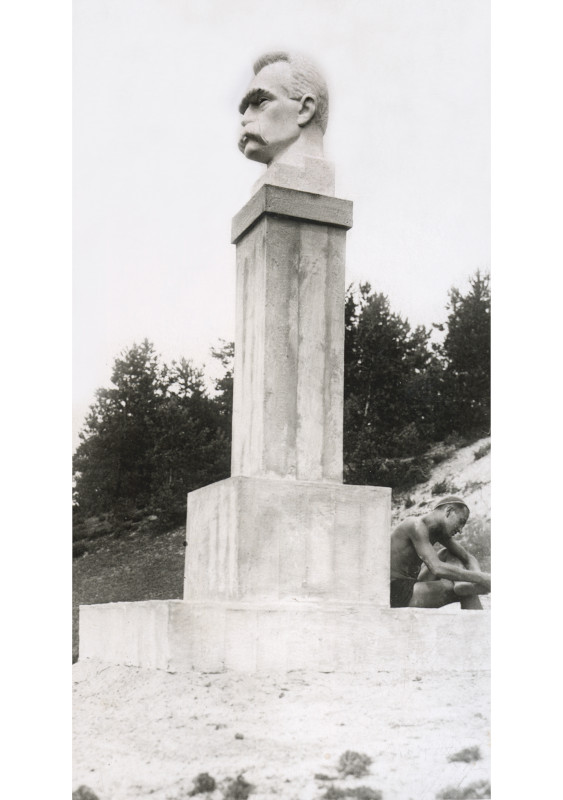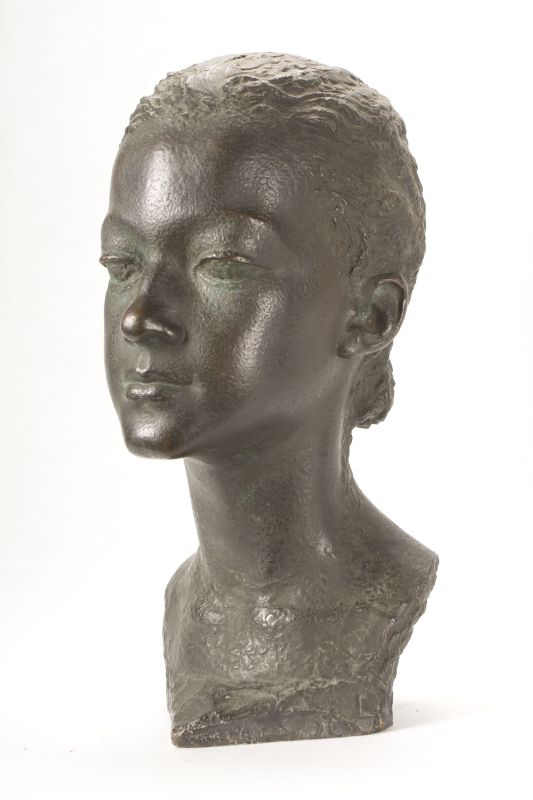-

Ludwik Koehler – a Print with the Artist’s Image, A. Karny, 1926, ink/paper
Apart from being an outstanding sculptor, Alfons Karny would also fulfill himself as a graphic artist. In the museum’s collection, one can see a cycle of woodcuts showing portraits of people distinguished in Poland’s history and culture. These include printed images of Józef Piłsudski, Władysław Reymont or Stefan Żeromski. Of special interest is the woodcut portrait of Ludwik Koehler; in the 1920s, he ran courses of drawing and painting in Białystok and Alfons Karny was one of his pupils. -

Portrait of Józef Piłsudski, A. Karny, 1928, plaster, patina
The permanent exhibition includes a portrait of Marshal Józef Piłsudski of 1928. This work is a study for a bronze statue unveiled in summer of 1936 in the Eastern Borderlands of the Second Republic – in Brasław. Nowadays, the town of Brasław is located in norther Belarus, and the Piłsudski’s monument, thoroughly concealed throughout World War 2, finally wound up at the Józef Piłsudski Museum in Sulejówek. -

Diploma of the first prize at the International Exposition of Art and Technology in Paris, 1937, pap
In 1937, Alfons Karny received a gold medal at the International Exposition of Art and Technology in Paris. The overarching theme of the Polish Pavilion were Józef Piłsudski’s words spoken over the coffin of the great poet Juliusz Słowacki at the Wawel Castle: “There are people and there are human deeds so strong and so powerful that they overcome death, that they live among us and commune with us”. The interior of the honorary hall was to reflect the connection between “what is lasting from the past with what is new in the creative effort” of Poland. Therefore, portraits of the most important persons in the history of Poland were presented at the honorary hall, including: Józef Piłsudski (by T. Breyer), Nicolaus Copernicus (by X. Dunikowski), and Frederic Chopin (by A. Karny). The monumental portrait of Frederic Chopin brought Karny a medal. -

Gilded ceramics, 1960s
Of special interest are the gilded ceramic sculptures made by Alfons Karny. The museum’s collection includes five items – such as the Portrait of Ignacy Jan Paderewski, Portrait of a Seaman from “Orzeł”, or Self-Portrait of Alfons Karny. All of these works are presented at a permanent exhibition at the Alfons Karny Museum of Sculpture. -

Portrait of Stanisław Noakowski, 1960, A. Karny, glazed ceramics
In the 1950s, Alfons Karny started departing from making of his sculptures in bronze. His area of interest included ceramics. Very often, he would reproduce his works, paying attention to the kind of glaze he used. This can be seen particularly well in case of the portrait of Stanisław Noakowski, the sculptor’s mentor and friend. Alfons Karny very aptly characterized his approach to sculpture in the “Głos plastyków” magazine in 1937: “I look for the everlasting peace and everlasting aesthetic joy in a pretty, soft line, harmonious, quiet and titanic at the same time, without any hint of drama, quandary, pain and disbelief”. -

Self-Portrait, A. Karny, 1930, bronze
“Self-Portrait” is one of the earliest surviving works by Alfons Karny. One can see a typically academic form, devoid of a psychological outline, and its shape combines a soft, harmonious line with a firm structure of the piece. -

When I Was Thirteen Months Old, A. Karny, 1938, bronze
Particulary important in Alfons Karny’s output was the subject of a child; during the inter-war period, it symbolized Poland reborn. Apart from such sculptures as “After the Jam Has Been Eaten”, the museum’s collection includes a portrait of Alfons Karny at the age of thirteen months. This work was created for the “Polish Child in Art” competition and won the first prize. -

Portrait of Prof. Jan Czochralski, A. Karny, 1944, bronze
The Gallery of Portraits of Great Poles includes images of many scientists. Among them is Jan Czochralski – a world-famous Polish chemist. Apart from his achievements in exact sciences, he was known for his charity efforts. It was him who Karny was indebted to for financing of casts of many of his sculptures. -

Portrait of Ludwik Solski, A. Karny, 1944, bronze
During World War 2, Alfons Karny would organize meetings of a secret university at his atelier on Wiejska Street. The sculptor would reminisce about them as follows: “There were several dozen people at my atelier. The wooden floor would bend under that weight. In case the Germans caught us, we had an excuse it was a party to celebrate a new sculpture”. The invited guests included the actor Ludwik Solski. In his sculpture, Karny captured the psychological image of his model. While posing to the portrait, Solski was almost 90 years old. -

Portrait of the sibling Dzidek Korzybski, A. Karny, 1940-1941, bronze
In the 1920s, Alfons Karny came to Warsaw to study at the School of Fine Arts. The artist was struggling with health issues – he suffered from anemia and also had impaired sight. In his infirmity, he was helped by doctor Marian Korzybski. In exchange for his help, Karny carved the portraits of two of his children: Dzidek and Jola – participants of the Warsaw Uprising. -

Portrait of the sibling Jola Korzybski, A. Karny, 1940-1941, bronze
In the 1920s, Alfons Karny came to Warsaw to study at the School of Fine Arts. The artist was struggling with health issues – he suffered from anemia and also had impaired sight. In his infirmity, he was helped by doctor Marian Korzybski. In exchange for his help, Karny carved the portraits of two of his children: Dzidek and Jola – participants of the Warsaw Uprising.










